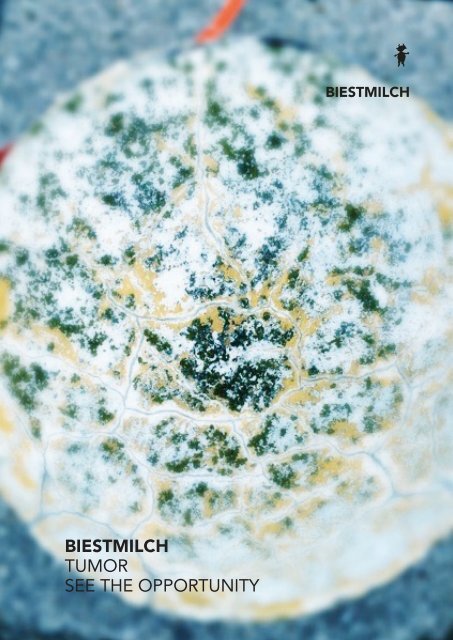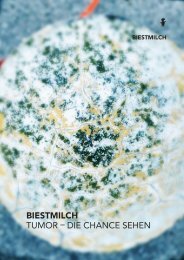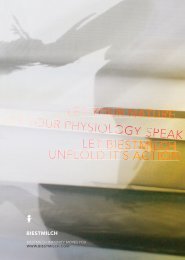Tumor – see the opportunity
Susann Kraeftner, MD – If you would like to pluck up the courage to make your own decisions; if you don‘t want to let the opinions of others make you doubtful, those presented to you in the outside world and inside clinics and health care centers, inside the territories of science where one believes to have entered the realm of truth, if you have realized for yourself that the only right way is the way you have chosen for yourself, then give in to reading the next pages. If you have questions feel free to ask www.biestmilch.com/helpdesk
Susann Kraeftner, MD – If you would like to pluck up the courage to make your own decisions; if you don‘t want to let the opinions of others make you doubtful, those presented to you in the outside world and inside clinics and health care centers, inside the territories of science where one believes to have entered the realm of truth, if you have realized for yourself that the only right way is the way you have chosen for yourself, then give in to reading the next pages. If you have questions feel free to ask www.biestmilch.com/helpdesk
Create successful ePaper yourself
Turn your PDF publications into a flip-book with our unique Google optimized e-Paper software.
Biestmilch<br />
BiestmiLch<br />
TUMOR<br />
See <strong>the</strong> <strong>opportunity</strong><br />
|<br />
1
In order to understand Biestmilch, you have to set<br />
forth and leave <strong>the</strong> beaten tracks. The story I would<br />
like to tell you is <strong>the</strong> one of <strong>the</strong> orbit in <strong>the</strong> universe<br />
of biology that Biestmilch is moving along. It is a long<br />
story, one I can only touch on here. It is one thing to<br />
analyse Biestmilch as a substance and break it up into<br />
its individual parts. However, that would be like having<br />
“reckoned without our host”. Ra<strong>the</strong>r, approaching<br />
Biestmilch also means occupying yourself with your<br />
own body, with <strong>the</strong> physiology holding us toge<strong>the</strong>r<br />
deep inside. You could compare this process with an<br />
expedition.<br />
FOR OUR FOREFATHERS, BIESTMILCH<br />
WAS A FOODSTUFF AND A CURE<br />
Fresh Biestmilch contains everything a newborn child requires.<br />
It contains sufficient fat, bacterial microflora, immunglobulins,<br />
hormones, vitamins, minerals, micronutrients,<br />
mucopolysaccharides and a large number of cell<br />
communication molecules. In <strong>the</strong> first five to six days after<br />
birth, it is slowly converted into milk and <strong>the</strong>n loses its<br />
unique character. Although it is possible to break down<br />
Biestmilch into its individual parts, we will not, however,<br />
learn its great effects by doing so.<br />
The way Aristotle put it also applies to Biestmilch:<br />
“<strong>the</strong> whole is greater than <strong>the</strong> sum of <strong>the</strong> parts”.<br />
2<br />
Biestmilch<br />
TUMOR <strong>–</strong> See The OppORTUniTy
TUMOR<br />
See <strong>the</strong> <strong>opportunity</strong><br />
Susann Kraeftner, MD<br />
If you would like to pluck up <strong>the</strong> courage to make your<br />
own decisions; if you don‘t want to let <strong>the</strong> opinions of<br />
o<strong>the</strong>rs make you doubtful, those presented to you in<br />
<strong>the</strong> outside world and inside clinics and health care<br />
centers, inside <strong>the</strong> territories of science where one believes<br />
to have entered <strong>the</strong> realm of truth, if you have<br />
realized for yourself that <strong>the</strong> only right way is <strong>the</strong> way<br />
you have chosen for yourself, <strong>the</strong>n give in to reading<br />
<strong>the</strong> next pages.<br />
OCCUPY YOURSELF WITH BIESTMILCH.<br />
Here, you can find texts I wrote about a natural remedy<br />
that in my opinion cannot be topped when it comes to<br />
<strong>the</strong> strength and diversity of its effect. And note: Biestmilch<br />
is not harmful to you, doesn‘t hurt you. In order<br />
to understand Biestmilch, you will have to say goodbye<br />
to conventional ways of thinking. There‘s no need to<br />
distance yourself from scientific knowledge but you do<br />
have to move along <strong>the</strong> borders of science where rethinking<br />
takes place and new things come to life.<br />
A TUMOR IS NOT AN ACCUMULATION<br />
OF MALICIOUS CELLS<br />
You may find that sounds like a provocation. I would<br />
now like to tell you why that is not <strong>the</strong> case and why<br />
this scientific observation uncovers great opportunities<br />
for you.<br />
Scientists have now also recognized that <strong>the</strong> opinion<br />
of a tumor comprising an accumulation of malicious<br />
cells, which have withdrawn <strong>the</strong>mselves from growth<br />
control, is not true. This scientific insight is thus to be<br />
discarded and become history.<br />
A NETWORK OF REGULATORY CIRCUITS<br />
CONTROLS THE BALANCE OF THE CELLS<br />
Cancer cells give evidence of defects in <strong>the</strong> regulatory<br />
circuits which control cell proliferation and <strong>the</strong><br />
balance between growth and stagnancy or guide regeneration<br />
and <strong>the</strong> dying-off of <strong>the</strong> cells. This process<br />
of maintaining <strong>the</strong> balance is so varied and can be<br />
disturbed in so many places meaning that today, we<br />
can differentiate between more than 100 types and<br />
subtypes of tumors within one single organ. In o<strong>the</strong>r<br />
words, no one type of cancer resembles <strong>the</strong> o<strong>the</strong>r.<br />
How many regulatory circuits in a target cell need to<br />
be broken to stop a tumor from growing and whe<strong>the</strong>r<br />
<strong>the</strong> same or similar regulatory circuits in every tumor<br />
cell are affected in <strong>the</strong> various tumors remains unknown<br />
to this day. Which regulatory circuits in <strong>the</strong> cells<br />
run independently from <strong>the</strong> environment and which<br />
are coupled to signals from <strong>the</strong> micro-environment<br />
is likewise unexplored. Whe<strong>the</strong>r <strong>the</strong> large number of<br />
cancer-related genes can be tied to certain regulatory<br />
circuits also needs to be researched.<br />
|<br />
3
<strong>Tumor</strong> cells lose <strong>the</strong>ir ability to<br />
communicate.<br />
4<br />
BIESTMILCH<br />
<strong>Tumor</strong> <strong>–</strong> <strong>see</strong> <strong>the</strong> <strong>opportunity</strong>
A GENETIC DEFECT ALONE DOES NOT<br />
NECESSARILY LEAD TO A TUMOR DEVELOPING<br />
It can take decades for a tumor to reach a size of medical<br />
significance, i.e. until disorders become evident. <strong>Tumor</strong>s<br />
usually grow very slowly and, in addition to that, a series<br />
of unfortunate circumstances must concur. A defect in <strong>the</strong><br />
DNA is not sufficient to make a tumor develop and that is<br />
why a tumor is not simply a collection of malicious cells<br />
whose growth proceeds in an aggressive and uncontrolled<br />
way. And because of this fact, a suitable lifestyle can very<br />
much prevent <strong>the</strong> development of a tumor.<br />
Thus, for a tumor to start growing, a number of factors<br />
must concur. - There are disorders of <strong>the</strong> cell biology on<br />
<strong>the</strong> level of <strong>the</strong> cell core, <strong>the</strong> cytoplasm, <strong>the</strong> receptors, <strong>the</strong><br />
extra-cellular matrix and <strong>the</strong> neighboring cells. The underlying<br />
processes are arranged on a time basis in 3 phases:<br />
1) <strong>the</strong> initiation of <strong>the</strong> DNA,<br />
2) <strong>the</strong> promotion in <strong>the</strong> intra- and<br />
extra-cellular environment and<br />
3) <strong>the</strong> progression through tumor-specific<br />
communication processes beyond <strong>the</strong> primary tumor.<br />
First of all, <strong>the</strong> cell experiences a genetic change, it is initiated.<br />
It can linger or pause in this state for centuries on<br />
end. This means a tumor never grows. So, as you <strong>see</strong>, a<br />
genetic defect does not suffice to produce a tumor. However,<br />
if such a cell experiences an irritation such as <strong>the</strong> influence<br />
of a carcinogen or a chronic inflammatory change<br />
to its environment, <strong>the</strong>n <strong>the</strong> genetic defect manifests in<br />
<strong>the</strong> development of a tumor. A chronic inflammatory environment<br />
gives this genetically weak cell a growth advantage<br />
over o<strong>the</strong>r cells.<br />
THE TUMOR CELL GROWS INDEPENDENTLY<br />
No cell can multiply itself without <strong>the</strong> stimulating signals.<br />
In contrast, a tumor cell grows independently; it loses its<br />
coupling to <strong>the</strong> environment. Many oncogenes function by<br />
copying normal growth signals.<br />
The bridging molecules (connexins) are molecules that are<br />
essential for <strong>the</strong> communication between cells. Stem cells<br />
are characterized by not carrying such connexins on <strong>the</strong>ir<br />
surface. Thus, <strong>the</strong>y have no bridges for communicating<br />
with o<strong>the</strong>r cells. These bridging molecules are significantly<br />
involved in controlling <strong>the</strong> growth of cells and tissues.<br />
Communication is thus an important control process.<br />
A characteristic cancer cell:<br />
1) Self-sufficiency of growth signals<br />
2) Insensitive towards <strong>the</strong> growth of repressive signals<br />
3) Infiltration of cell termination (apoptosis)<br />
4) Endless potential for proliferation<br />
5) Maintaining <strong>the</strong> formation of vessels<br />
6) Penetration into <strong>the</strong> tissue and metastasis<br />
THE CELL‘S ENVIRONMENT IS JUST<br />
AS IMPORTANT AS THE CELL ITSELF<br />
In science, one speaks of epigenetic processes, which play<br />
a central role in <strong>the</strong> development of tumors.<br />
As you know, <strong>the</strong> cell comprises one cell nucleus in which<br />
chromosomes, <strong>the</strong> DNA, <strong>the</strong> genetic material so to say are<br />
located. Cytoplasm, in which a large number of accumulations<br />
of molecules form structures that are necessary for<br />
<strong>the</strong> cell to live and to become what it is and what it does,<br />
surrounds this cell nucleus. The cell as a whole is surrounded<br />
by a membrane just like <strong>the</strong> cell nucleus is. All structures<br />
that form this kind of cell have, on <strong>the</strong> one hand, Anteile<br />
which have a very flexible shape (receptors, ligands)<br />
and continuously send and receive signals. On <strong>the</strong> o<strong>the</strong>r<br />
hand, <strong>the</strong>y fulfill certain tasks in <strong>the</strong> cell such as cell respiration<br />
or protein biosyn<strong>the</strong>sis. Thus a stream of signals<br />
flows through <strong>the</strong> cell, which leads from <strong>the</strong> cell nucleus to<br />
<strong>the</strong> environment surrounding <strong>the</strong> cells and back. In simple<br />
terms, it is a never-ending loop. The resulting changing<br />
signal patterns influence <strong>the</strong> specific functional state of<br />
<strong>the</strong> cell. Irrespective of what function a cell has, in principle,<br />
all cells work according to <strong>the</strong> same principle, and<br />
because <strong>the</strong>y all work in this way, <strong>the</strong> cells on <strong>the</strong> various<br />
levels can be influenced in terms of both place and time.<br />
Cell growth is thus not a phenomenon that is controlled<br />
solely by <strong>the</strong> cell nucleus and its genetic material. The cell<br />
is closely connected to its environment, exchange is narrow<br />
and intensive. Not only do signals/impulses/messages from<br />
<strong>the</strong> interior of <strong>the</strong> cell reach <strong>the</strong> cell‘s surroundings, thus<br />
changing <strong>the</strong> cell‘s state, but signals/impulses/messages<br />
from <strong>the</strong> environment likewise inlfuence <strong>the</strong> cell‘s and <strong>the</strong><br />
nucleus cell‘s function and activity. In this way, <strong>the</strong> cells and<br />
<strong>the</strong> space between <strong>the</strong>m form an entity of brisk exchange.<br />
|<br />
5
TUMORS DEVELOP IN CHRONIC<br />
inflammatory ENVIRONMENTS<br />
Virchow saw a correlation between inflammation and tumor<br />
back in 1863. Ever since, research has been changing<br />
in such a way that can barely be compared to those times.<br />
And yet, this postulate gained more relevance than ever.<br />
In <strong>the</strong> meantime we know from some chronic viral infections<br />
that <strong>the</strong>y can make <strong>the</strong> way for tumors to develop.<br />
And <strong>the</strong> same applies to chronic inflammations like rheumatism<br />
or chronic inflammatory gastro-intestinal diseases.<br />
Inflammations are usually self-limiting processes. With a<br />
fine-tuned immune response, <strong>the</strong> immune system makes<br />
sure that inflammatory and anti-inflammatory processes<br />
ultimately lead to healing. Characteristic of <strong>the</strong> immune<br />
situation of tumor patients is <strong>the</strong> fact that <strong>the</strong> immunity<br />
is weakened (suppressed). When a tumor start to grow or<br />
metastasize, <strong>the</strong>n it has usually already infiltrated <strong>the</strong> immune<br />
system with its monitoring strategies. An intact immune<br />
system patrols <strong>the</strong> body and removes <strong>the</strong> cells that<br />
are no longer behaving properly.<br />
Dvorak recognized <strong>the</strong> similarities between wound healing<br />
and tumors back in 1986. In contrast to a tumor, a wound<br />
heals itself. In a tumor, <strong>the</strong> process continues by factors<br />
being released unremittingly, which maintain <strong>the</strong> inflammation.<br />
As is <strong>the</strong> case with wound healing, <strong>the</strong> formation<br />
of vessels in <strong>the</strong> scope of a tumor emerging plays an important<br />
role for a tumor that measures more than one to<br />
two millimeters, blood vessels are vital.<br />
TO PUT IT A NUTSHELL:<br />
In order for a malignant tumor to start growing, an external<br />
or internal trigger, an inflamed environment and damage to<br />
<strong>the</strong> DNA must concur. An improbable event for an individual?<br />
Many malignant tumors are triggered off by infections. A<br />
history of infection can be assigned to more than 15% of all<br />
tumors worldwide; that is more than 1.2 million cases a year.<br />
Thus, tumors develop as <strong>the</strong> result of a multi-leveled process,<br />
which leads from an initial benign change to <strong>the</strong> cells to an<br />
invasive and <strong>the</strong>n metastasizing disease. This process takes<br />
many years until it has fully developed. The long period this<br />
process requires strongly implies that it has to assert itself<br />
against a background of strict and diversified control mechanisms<br />
that are supposed to prevent anarchical cell behavior.<br />
It is thus probable that a certain environment tied to a genetic<br />
disposition changes <strong>the</strong> cells to such an extent that <strong>the</strong>y<br />
become more receptive for endogenous and exogenous carcinogen<br />
influences. It may depend on whe<strong>the</strong>r <strong>the</strong> carcinogens<br />
can actually trigger off tumor growth and how long it<br />
takes until <strong>the</strong> process is clinically proven.<br />
IF YOU WANT TO KNOW MORE THEN<br />
YOU MAY BE interested IN WHAT HYPOTHESES<br />
SCIENTISTS ARE CURRENTLY WORKING WITH.<br />
One hypo<strong>the</strong>sis reads as follows: The cell reveals a gene<br />
defect that can no longer be repaired. For this reason, <strong>the</strong><br />
external appearance of <strong>the</strong> cell deviates from that of <strong>the</strong><br />
normal cell. Such a cell no longer divides itself up asymmetrically<br />
into a cell with a function (effector cell), which<br />
depends upon which organ or apparatus it is allocated to<br />
and into a stem cell but symmetrically into two cells with<br />
functions. Yet, it is not a tumor cell. As long as <strong>the</strong> environment<br />
surrounding <strong>the</strong> cell suppresses cell proliferation, a<br />
tumor does not yet develop.<br />
If, however, a carcinogen or a chronically inflammatory<br />
changed environment affects <strong>the</strong> cell to <strong>the</strong> extent that<br />
<strong>the</strong> brake preventing cell proliferation is released, <strong>the</strong>n <strong>the</strong><br />
cell begins to proliferate in an uncontrolled manner. The<br />
result is a mass of cells such as polyps in <strong>the</strong> colon or papilloma<br />
in <strong>the</strong> skin. For a so-called malignant tumor to develop,<br />
a number of additional genetic or cellular changes<br />
must occur. It‘s not until now that <strong>the</strong> step towards <strong>the</strong><br />
tumor becoming malignant follows.<br />
Ano<strong>the</strong>r hypo<strong>the</strong>sis - worded by Potter back in 1978 - explains<br />
<strong>the</strong> emergence of a tumor as being a blockage of<br />
cell development on <strong>the</strong>ir way from <strong>the</strong> stem cell, where it<br />
still carries a large number of possibilities, to <strong>the</strong> cell that<br />
is equipped with <strong>the</strong> function determined for that cell. An<br />
interruption to this development can happen at any stage<br />
of this process. Influences from <strong>the</strong> cell‘s environment can<br />
speed up cell division and prevent <strong>the</strong> normal death of <strong>the</strong><br />
cell. You have probably often come across <strong>the</strong> term oncogene.<br />
More than 100 oncogenes have already been identified.<br />
Oncogenes are DNA parts that serve as <strong>the</strong> template<br />
for <strong>the</strong> syn<strong>the</strong>sis of protein substances with differing tasks<br />
like growth factors, receptors, signal-transferring molecules.<br />
The tumor suppressor genes have a quasi contrary<br />
task to <strong>the</strong> oncogenes. They form <strong>the</strong> template for <strong>the</strong><br />
growth of inhibitive factors such as bridging molecules.<br />
These are structural proteins in cell membranes that form<br />
channels for <strong>the</strong> direct transfer of small molecules and ions<br />
between <strong>the</strong> cells. The bridging molecules between <strong>the</strong><br />
cells are central structures of monitoring growth and differentiating<br />
normal cells. If a gene-defect cell still has bridging<br />
connections, it is still able to develop in its target cell<br />
to a certain extent. Its direct contact to <strong>the</strong> o<strong>the</strong>r cells in<br />
<strong>the</strong> network inhibits uncontrolled proliferation.<br />
6<br />
BIESTMILCH<br />
<strong>Tumor</strong> <strong>–</strong> <strong>see</strong> <strong>the</strong> <strong>opportunity</strong>
|<br />
7
In tumors, <strong>the</strong> bridging molecules are usually missing.<br />
That means that <strong>the</strong> cell loses an important component for<br />
its networking with <strong>the</strong> environment. An activated oncogene<br />
and an inactivated suppressor gene can permanently<br />
stimulate growth.<br />
The objective of <strong>the</strong> research is to make tumor treatment<br />
that is currently very poor more specific and targeted.<br />
TREATING THE TUMOR PRIMARILY MEANS<br />
INFLUENCING THE CELL‘S ENVIRONMENT<br />
Because no tumor is alike, nei<strong>the</strong>r in <strong>the</strong> same organ nor<br />
past organ boundaries, it can be concluded that targeted<br />
<strong>the</strong>rapeutic approaches are complex and require a casespecific<br />
approach.<br />
Here is an example from experimental research on how<br />
<strong>the</strong> appearance of <strong>the</strong> cell and thus its behavior can be<br />
changed by changing <strong>the</strong> cell‘s environment:<br />
With certain cell growth factors (colony-stimulating factors),<br />
tumor cells can be reprogrammed in such a way<br />
so that <strong>the</strong>y re-integrate into <strong>the</strong> tissue network with its<br />
control mechanisms, even if <strong>the</strong>y do remain genetically<br />
changed. This result isn‘t actually surprising after what<br />
was said about <strong>the</strong> significance of <strong>the</strong> environment for <strong>the</strong><br />
emergence of a tumor.<br />
THE BEST TUMOR THERAPY IS PREVENTION<br />
Because most tumors develop slowly over decades, prevention<br />
should stand in first place today. By prevention,<br />
we mean influencing <strong>the</strong> environment of <strong>the</strong> genetically<br />
altered cell. Prevention comprises healthy and good quality<br />
food. Eating is <strong>the</strong> most important environment modulator,<br />
closely followed by regular exercise, i.e. sport, because<br />
physical exercise activates <strong>the</strong> immune system and<br />
suppresses inflammatory processes that are smoldering in<br />
<strong>the</strong> body. It is also very important to not eat too much, i.e.<br />
restrict calories.<br />
Biestmilch belongs to <strong>the</strong> food plan (it is a foodstuff). It is<br />
a kind of immune serum, a substance that is able to calm<br />
down chronic inflammatory tissue.<br />
BIESTMILCH CAN MODULATE<br />
THE INFLAMMATORY ENVIRONMENT<br />
OF THE TUMOR<br />
The inflammatory response should actually contribute<br />
towards removing <strong>the</strong> tumor cells. However, in <strong>the</strong> case<br />
of humans with tumors, <strong>the</strong> inflammatory response is unproductive.<br />
Inflammatory and anti-inflammatory processes<br />
are no longer in balance but have displaced towards <strong>the</strong><br />
chronic inflammation. It is typical for <strong>the</strong> environment of<br />
<strong>the</strong> tumor for receptors to become insensitive meaning no<br />
effective antitumor response is generated.<br />
Today, <strong>the</strong> <strong>the</strong>rapeutic challenge principally lies in normalizing<br />
<strong>the</strong> deregulated inflammatory network in such<br />
a way that <strong>the</strong> result is a regular inflammatory response.<br />
Thanks to its diversity, Biestmilch as one of <strong>the</strong> very few<br />
substances available has this potential. Fur<strong>the</strong>rmore, it can<br />
stabilize <strong>the</strong> immune system for chemo<strong>the</strong>rapy to such an<br />
extent that subsequent metastasizing can be influenced.<br />
HOW TO TAKE BIESTMILCH:<br />
You should take Biestmilch every day. Make it part of your<br />
food plan. You don‘t interrupt <strong>the</strong> intake.<br />
Take 900 mg every day. If you are taking Biestmilch as<br />
preparation for chemo<strong>the</strong>rapy or in addition to that, increase<br />
<strong>the</strong> amount to 3 x 900 mg every day. After chemo<strong>the</strong>rapy<br />
reduce step by step to 900 mg or 600 mg. In <strong>the</strong><br />
case of a repeat chemo-cycle, please increase <strong>the</strong> dosage<br />
again to 3 x 900 mg.<br />
8<br />
BIESTMILCH<br />
<strong>Tumor</strong> <strong>–</strong> <strong>see</strong> <strong>the</strong> <strong>opportunity</strong>
Dr. Susann KrAEftner<br />
„My CV is <strong>the</strong> contrary of straightforward. I have experienced what<br />
it means to work in intensive care, and psychiatry, in <strong>the</strong> Civil War of<br />
Lebanon, and in <strong>the</strong> pharmaceutical industries. For many many years<br />
I was looking for escaping medicine and find a way to get involved<br />
with a more creative way of working. Since 2000 I pursue my life<br />
experiment to resuscitate Colostrum. We call it Biestmilch.“<br />
Find fur<strong>the</strong>r information and toughts about Biestmilch on<br />
www.biestmilch.com<br />
Sources of literature<br />
Coussens LM, Werb Z: Inflammation and cancer.<br />
Nature, 420: 860 <strong>–</strong> 867, 2002.<br />
O‘Byrne KJ, Dalgleish AG:<br />
Chronic activation and inflammation<br />
as cause of malignancy.<br />
British Journal of Cancer,<br />
85 (4): 473 <strong>–</strong> 483, 2001<br />
Shamgar B-E: The promotion of tumor metastasis<br />
by surgery and stress: immunological basis and<br />
implications for psychoneuroimmunology.<br />
Brain, Behaviour and Immunitiy, 17: 27 <strong>–</strong> 36, 2003<br />
Lotem J, Sachs L: Epigenetics wins over genetics:<br />
induction of differentation in tumor cells.<br />
Cancer Biology, 12: 339 <strong>–</strong> 346, 2002<br />
Trosko JE: The role of stem cells and gap junctional<br />
intercellular communication in caringenesis.<br />
Journal of Biochemistry and Molecular Biology,<br />
36 (1): 43 <strong>–</strong> 48, 2003<br />
Trosko JE: Chang CH-Ch, Upham BL, et al.:<br />
Ignored hallmarks of carcinogenesis: stem<br />
cells and cell-cell communication.<br />
Ann. N.Y. Acad. Sci., 1028: 192 <strong>–</strong> 201, 2004<br />
Hanahan D, Weinberg RA: The hallmarks of cancer. Cell,<br />
100: 57 <strong>–</strong> 70, 2000<br />
Impressum / IMPrint<br />
Biestmilch Seven GmbH<br />
Herderstraße 31<br />
65185 Wiesbaden, Germany<br />
BIESTMILCH USA, LLC<br />
1129 East Shorewood Court<br />
Coeur d‘Alene, ID 83815<br />
United States<br />
Concept + Text<br />
Dr. Susann Kraeftner<br />
Biestmilch Distribution<br />
TRIXSTERS GmbH<br />
Herderstraße 31<br />
65185 Wiesbaden, Germany<br />
Fon +49 (0)611 - 97651-0<br />
Fax +49 (0)611 - 97651-25<br />
biestmilch@biestmilch.com<br />
www.biestmilch.com/store<br />
Design<br />
designrs frankfurt<br />
www.designrs.de<br />
|<br />
9
Biestmilch<br />
WWW.BieStMiLCh.CoM/Store<br />
BIESTMILCH Chewables<br />
BIESTMILCH Capsules<br />
BIESTMILCH Solution<br />
BIEST BOOSTER MEDIUM*<br />
30 Chewable Tablets<br />
90 Capsules<br />
Flask à 125 ml,<br />
9 Chewable Tablets<br />
à 900mg Colostrum<br />
à 300mg Colostrum<br />
Only available in Europe<br />
à 4000mg Colostrum










